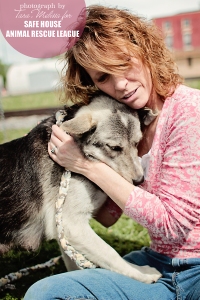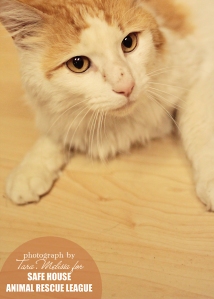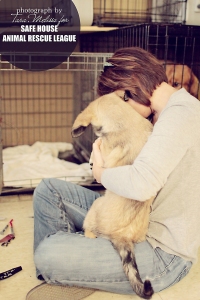If you’ve been following my posts lately, here or on Facebook, you may have noticed a deluge of animal photos. These are the faces of numerous cats and dogs in need of loving homes. Animal welfare has never been something that I considered myself passionate about. I have always loved having animals in my life. And my heart breaks for the multitude that is left out in the cold. Tortured, unloved. But I never pictured myself bearing such a burden for them.
That is, not until we recently adopted our cat, Milo. Milo is an orange and white short hair, and he has only one eye. He stole our hearts from the moment we saw his photo in an ad on Craigslist, and we consider ourselves blessed to be able to give him a loving home (and plenty of catnip covered mice…hahaha).
I suppose however, that it all really began a couple of years ago, when a malnourished dog with sarcoptic mange and nearly no fur left on his tired body, found his way into my life. After talking to a few local shelters, and hearing that he would likely be put down, I decided I had a dog! We were at the vet seeking treatment the next day. Baldwin is now a 125lb, 3-year-old, healthy and happy puppy, with a full coat of fur that sheds like CRAZY twice a year. I can’t imagine life without him. And I still have difficulty reconciling the fact that I live in a world that would rather kill than heal.
“We can judge the heart of a man by his treatment of animals” – Immanuel Kant
While Baldwin came to me as a stray, Milo was adopted from a rescue organization I now wholeheartedly support and volunteer for, the Safe House Animal Rescue League (part of me loves the fact that it sounds like a group of superheroes…and in fact, to the animals they rescue…they are!). Monica Frenden, founder of SHARL, agreed to share with me the story of how the rescue began, and what exactly it takes to run the organization.
Safe House Animal Rescue League (SHARL or Safe House, from here on out), based in Mendota, IL, began in 2008 as Illinois Valley Cat Taxi – a spay/neuter transport for cats. After moving into a farmhouse – complete with complimentary barn cats, Monica quickly realized that affordable and local spay/neuter was nowhere to be found, “…so I started taking them to PAWS Chicago for low-cost spay/neuter. I had several friends with the same story – farm cats who kept having kittens because people had no good alternative, so I offered to start taking them to the clinic with me, since I was going anyway. It started at 10 cats per trip, one day per month. Then 20 cats. Then 40, then 50 per week, for several years.”
During that time, Monica was also running a Trap-Neuter-Return (TNR) program. “Our TNR program is paid for solely through donations, fundraising, and grants. It costs us, on average around $55/cat to spay/neuter, vaccinate, microchip, and eartip a feral cat.”, says Monica. Please read this page on SHARL’s website, for more information on the TNR program.
As the TNR program was introduced into the local community, friendly cats and kittens would be found, but there was no suitable means of adoption for them. As Monica said, “The few no kill shelters were full and I certainly wasn’t going to send them to kill shelters. So we obtained our shelter license and developed a cat adoption program.”
SHARL also runs one of the country’s most successful barn cat programs. They are devoted to saving the lives of impounded feral cats, who can not be returned to their original locations. Safe House makes sure the cats are healthy, sterilized, vaccinated, and adopts them out to new homes with barns, stables, garages, or warehouses, where they live their lives as working cats – more than happy to dispose of unwelcome rodents. (p.s. there is no adoption fee for cats in the barn cat program, just a requirement that you can provide them with food, shelter, and long-term veterinary care as needed)
How did Safe House Animal Rescue League really take off though? Well, in Monica’s words, “Along the way we would come across the occasional stray dog or special dog who needed help, so we would help them too. In working with Chicago Animal Care & Control to take their feral cats for our barn cat program, we learned that they had lots of farm animals who were being killed because they didn’t know how to place them, so we started taking them home with us too. Pretty soon we were adopting cats, dogs, chickens, hedgehogs, and any number of other species and the IVCT name no longer represented all that we did. So we became Safe House.”
Safe House Animal Rescue League has become an organization near and dear to my heart, and in such a short amount of time as well. It’s easy to see how devoted and involved the volunteers are, how loving and committed the foster families are, and it’s truly uplifting.
SHARL’s volunteers put in about 700 hours per month, the equivalent of 4 full-time employees. This does not include special events, or the countless hours foster families put into loving and caring for each animal they’re given until they are adopted out. Every single person involved with Safe House is an unpaid volunteer, no one receives financial compensation or incentives.
I know that Safe House does a lot of work with comparatively few volunteers, and a very limited budget, so I asked Monica to explain what type of work the volunteers do, and what goes on from intake to adoption. Settle in, but it’s well worth reading.
Tara: “Where do your animals come from, and how do you choose them?”
Monica: “Our cats primarily come from our TNR program or are local strays we come across. We also take from the kill-lists at animal controls as space allows. We take every single cat from Lee County ACC, because no one else will. Fortunately, it’s not that many from LCAC. Every single barn cat we take in comes from a euthanasia room of an animal control facility, or very rarely from a local situation where the cats must be relocated to save their lives (hoarders, someone poisoning them, etc.)
Our dogs come exclusively from kill lists at animal controls.” – That’s right. Every single one of those darling canine faces I post, has been on the kill list at an animal control facility.
“We have a new program called Safety Net that helps people re-home their pets themselves without having to relinquish them to shelters at all. This not only prevents pets from entering a stressful shelter environment, but it frees up those spaces for animals on the kill list who really need it [to be saved]. Jami [Bonnewell] works this program for us and networks the animals online, gives them tips on behavior resolution, pet friendly housing info, and we offer free food & supplies & spay/neuter if the reason for surrender is financial.”
“Kelly Abrahamson-Darby is our Dog Rescue Coordinator and she works with the ACC’s where our dogs come from, as well as determines their foster placement. Kelly gets the kill lists each week from all the shelters we work with, and several that we don’t, and she has to select which dogs we can save that week. This gets difficult for obvious emotional reasons…If we can’t take them all, Kelly will start networking them online, posting their photos, begging for fosters, contacting other rescues and shelters to see if they can help.”
“We also have to apply business decisions to living beings, which is always a conflict. We know if we take in 15 senior black pit bulls with behavior or medical issues, that our adoptions and revenue will plummet, and then we can’t help any dogs. We’ve had to learn the demographics of our audience here and learn that our area adopts a lot of larger dogs, herding dogs, and working dogs, so we get to help a lot of those since they adopt quickly. However, we are NOT the kind of rescue who takes only purebred highly adoptable puppies (ahem, Pet Project). We try to run at an 80/20 ratio of fast track/slow track dogs but we are ultimately bleeding hearts for special needs critters and seniors who have lost their human.
Farm critters: these all come from ACC’s who have them brought in & they have no idea what to do with them. We take chickens, geese, ducks, guineas, swans, pigs, sheep, goats – and we always have a waiting list for goats and sheep. In all cases, an ACC calls us asking for help because they heard from someone, that we can take these animals. Interesting tidbit – goat neuters are cheaper than cat neuters. Perhaps that’s why we don’t have a feral goat problem in the US, ha ha. Farm critters are all spay/neuter if species appropriate and given whatever specialized care they need. We have an avian vet just for the birds and a farm vet just for the livestock critters.”
Tara: “What is your intake procedure, once the animals are brought in?”
Monica: “Once the cats arrive, they are scanned for microchip, vaccinated for 5 contagious diseases, tested for FIV and FeLV, and are quarantined from the herd for 14 days, usually in foster homes. They are dewormed, have flea/tick applied, are checked for ringworm with a special UV light called a Wood’s Lamp, given an all over body exam & treated for anything extra needed like ear mites. They are scheduled for spay/neuter if needed, microchipped if needed, given a rabies vaccination by the vet, and then they are adoption ready. In 14 days, if still with us, the cat is 5-way vaccinated & dewormed again. Once adoption ready we try and get photos, post the cat on Petfinder and Adopt-a-pet, we feature them on Facebook and Twitter, Craigslist, and the local newspaper. They to go special adoption events if they’re good candidates for that. If the cat is totally healthy and needs no other veterinary care of any kind, this care costs around $100, plus overhead items like food, litter, toys. Our average length of cat stay is about 6 weeks, unless it’s a barn cat and their length of stay is about 3 days.
“Dogs arrive and are scanned for microchip, vaccinated for 4 diseases, dewormed, given flea/tick prevention, given heartworm prevention if tested negative, and given a good going-over. They are scheduled for spay/neuter and anything else needed. Dentals are scheduled on about 20% of our dogs. More vaccines, flea/tick, heart worm prevention is given as needed throughout their stay with us. They’re then shipped off to foster with all the food and supplies they need & are listed for adoption when ready. [The cost of care for] dogs average about $200/ea. if they do not need dentals or any other veterinary care. Our average length of stay for dogs is about 12 days.”
I was curious about the cost difference in adoption fees vs the shelter’s care costs, but Monica later went on to explain, “The difference between adoption fee and cost of care is made up through donations and fundraising. We work with several spay/neuter clinics, as well as several local vets to have the adoptable animals vetted before adoption.”
Tara: “What are the biggest struggles you’ve come up against?”
Monica: “Our biggest struggles right now are financial and having a population that isn’t terribly progressive, much less on animal welfare. If we had a shelter facility we could double our adoption numbers overnight, or even more, but paying for it is always out of range. Local government has no desire to fund animal welfare issues, and has even less interest in endorsing even more ambitious no kill initiatives. We have a hard time with an aging and decreasing population, and a high percentage of low-income families. We do not qualify for many grant opportunities due to the low population here and the fact that we have no animal control facility to measure efficacy against. More and more plants close, people are struggling. So not only are donations down, but more pets are needing help because they are surrendered or abandoned due to economy, and more and more young people (the most active volunteers) move away each year. Very little financial support we receive comes from local sources. The majority of it comes from Chicago, Milwaukee, and abroad, from online marketing.”
Tara: “Any support you’ve unexpectedly encountered?”
Monica: “The biggest surprise, despite the biggest obstacle, is that every single time we have needed financial help to save an animal, people have come forward to help. (Not local people, sadly – but people from all over the world.) When Grace, our tripod cat, was shot, I believe she had donors from 36 states and 4 countries. We see that time and again. It’s what enables us to help the special needs animals, we know we can count on supporters from all over the world.”
You can likely see why Safe House has fast become a passion of mine. I firmly believe that better photos of adoptable animals generate more interest, and in the end, lead to a quicker adoption. Which, is why I now volunteer my photography services to Safe House whenever they need me. If you would like to help, in any way (and there are so many ways you can!), please head to this page to see how you can get involved. And please, share this post, spread the word! After all, Safe House is only as strong as its community.
{Tara.Melissa}
Contact the Safe House Animal Rescue League
__________
A final thought from Monica:
” …the name came about from all of us volunteers saying that we all must have a beacon light that leads all the wayward animals to us, because they always seemed to find us. A lantern in the window has always been the sign of a safe house, including the lore of window lanterns in the days of the underground railroad indicating a safe house. There is also a wonderful hobo sign of a cat that means ‘safe house’ to the homeless population. So if and when we get our shelter facility, we all envisioned a tall barn with a light that is always lit in the steeple to guide the way for wayward critters.”
__________
The following are photographs of volunteer Jami, and founder Monica, working on pups during intake procedure.















